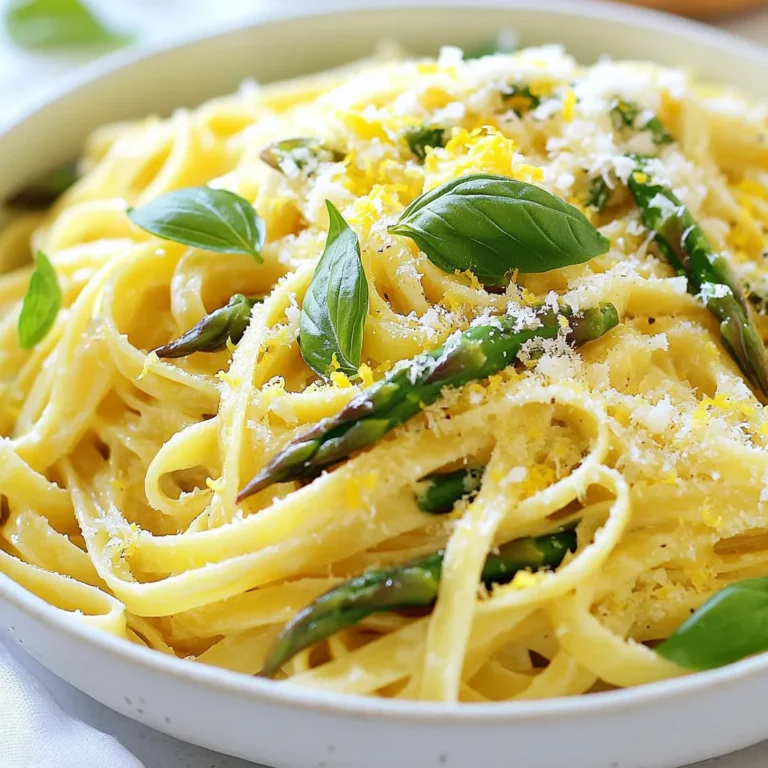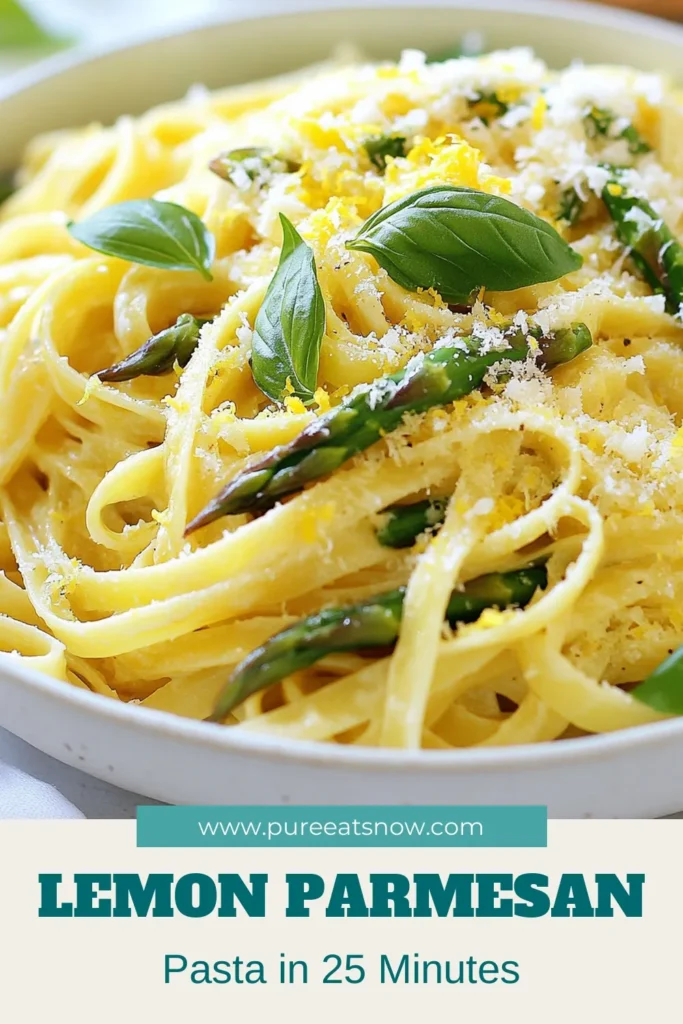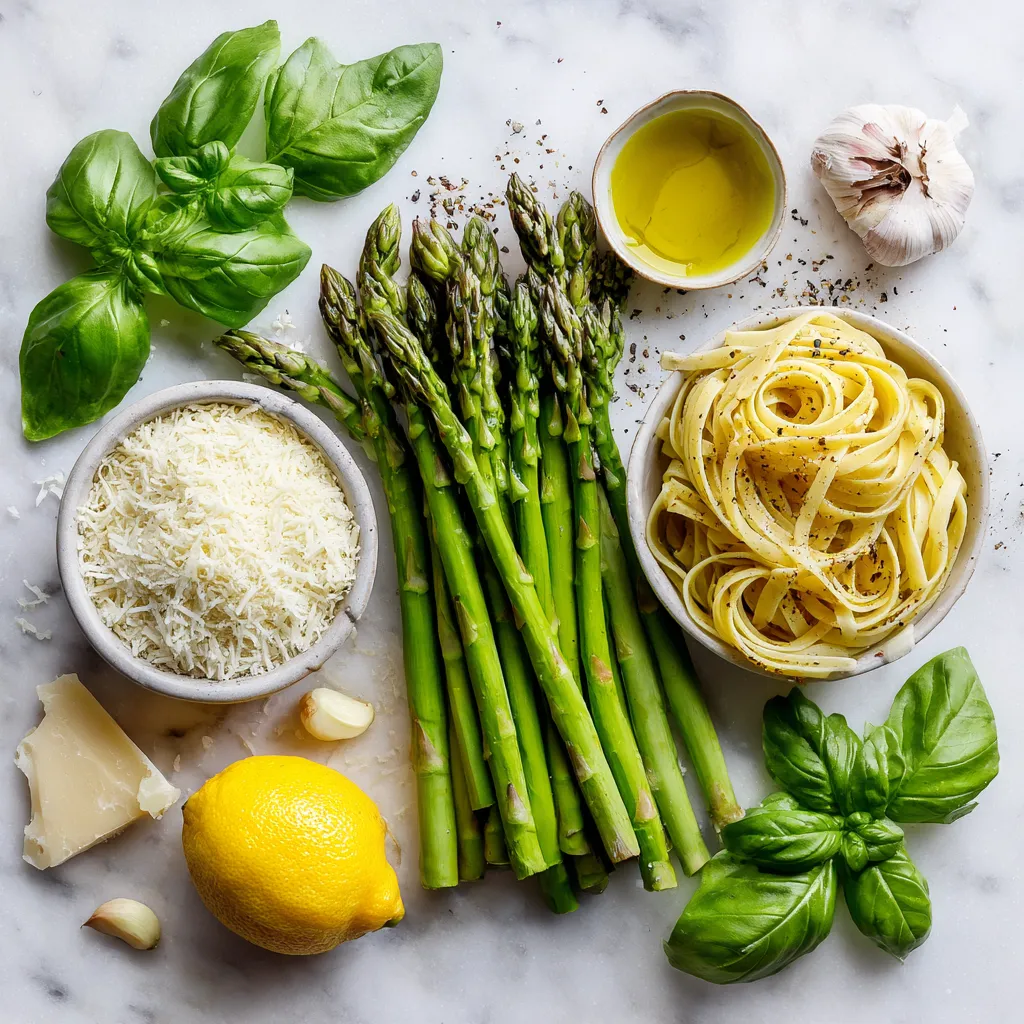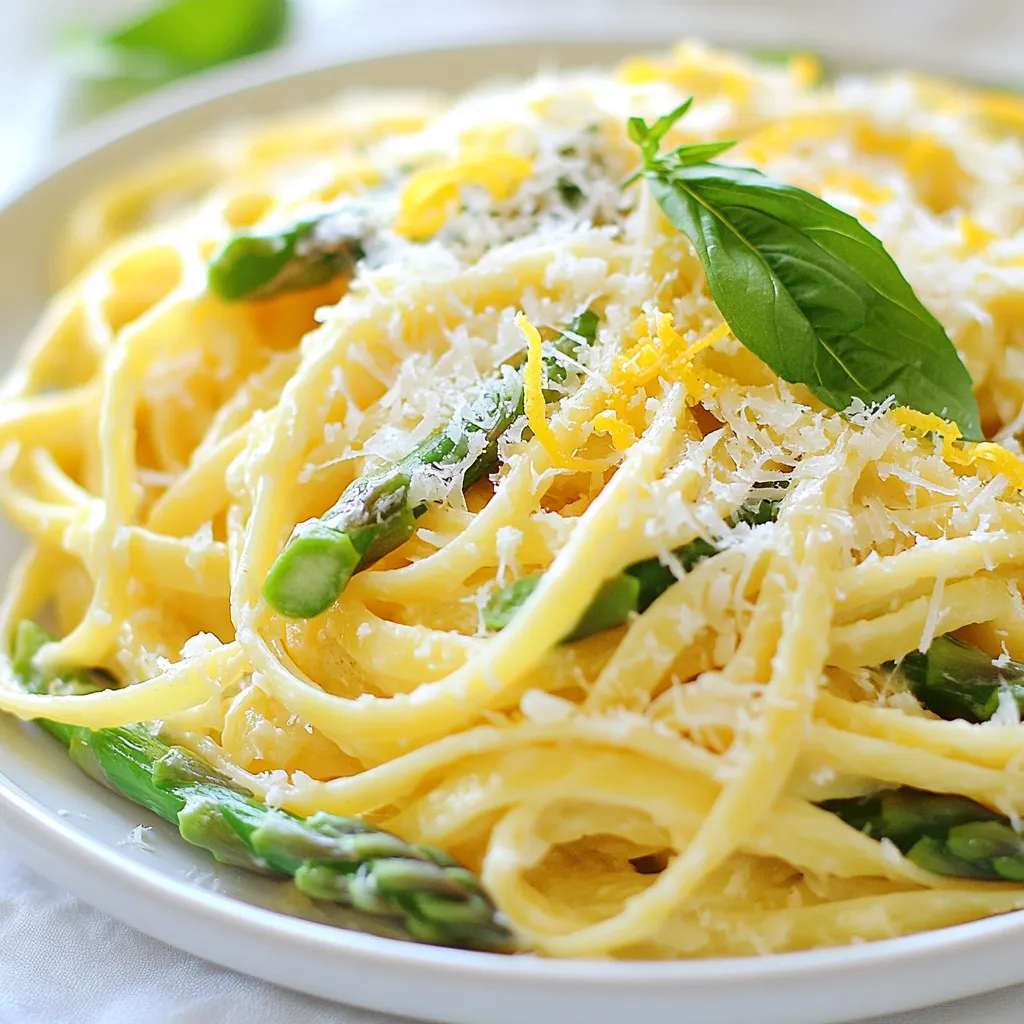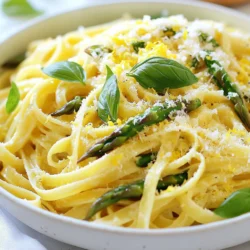WANT TO SAVE THIS RECIPE?
Looking for a fresh and tasty meal that’s quick to make? My Lemon Parmesan Asparagus Pasta is just what you need! With simple ingredients like fettuccine, fresh asparagus, and a zesty lemon kick, this dish bursts with flavor. Whether you’re cooking for family or treating yourself, this recipe is sure to impress. Ready to dive into a delicious, easy dish? Let’s get started!
Why I Love This Recipe
- Fresh Ingredients: This recipe showcases the vibrant flavors of fresh asparagus and bright lemon, making it a perfect choice for spring and summer meals.
- Quick and Easy: With a total time of just 25 minutes, this pasta dish is perfect for busy weeknights or last-minute gatherings.
- Creamy Without the Guilt: The addition of Parmesan cheese provides a creamy texture and rich flavor without the need for heavy cream.
- Customizable: This recipe is versatile; you can easily add protein like chicken or shrimp or swap out the pasta for a gluten-free option.
Ingredients
Main Ingredients
– 8 oz fettuccine or tagliatelle pasta
– 1 lb fresh asparagus, trimmed and cut into 2-inch pieces
– 2 tablespoons olive oil
Additional Flavorings
– 3 cloves garlic, minced
– Zest and juice of 1 lemon
– 1 cup grated Parmesan cheese
Seasonings and Garnishes
– Salt and pepper
– Fresh basil leaves for garnish (optional)
In this recipe, the main ingredients are simple and fresh. The pasta forms the base of the dish. I prefer fettuccine or tagliatelle for their width, which holds the sauce well. Fresh asparagus adds a nice crunch and bright flavor. Olive oil is key for sautéing and brings richness to the dish.
Next, we add flavor with garlic and lemon. Garlic gives a warm aroma that complements the asparagus. Lemon zest and juice add a bright, tangy flair. Finally, Parmesan cheese adds creaminess and depth.
Don’t forget the seasonings! Salt and pepper enhance every bite. Fresh basil leaves make a lovely garnish and add a pop of color. This combination of ingredients creates a tasty and vibrant meal.

Step-by-Step Instructions
Cooking the Pasta
To start, boil water in a large pot. Add salt to the water for flavor. Once the water is boiling, add 8 ounces of fettuccine or tagliatelle pasta. Cook it as per the package instructions until it is al dente. This usually takes about 8 to 10 minutes. After that, save 1 cup of the pasta water. Drain the pasta in a colander and set it aside.
Blanching the Asparagus
Next, grab another pot and fill it with water. Bring this water to a boil. Add 1 pound of fresh asparagus cut into 2-inch pieces. Blanch the asparagus for about 2 to 3 minutes. It should turn bright green and get tender yet crisp. Once ready, drain the asparagus and plunge it into a bowl of ice water to stop cooking. After a few minutes, drain it again.
Sautéing and Combining Ingredients
In a large skillet, heat 2 tablespoons of olive oil over medium heat. Add 3 cloves of minced garlic and sauté for about 1 minute. You want to smell the garlic but avoid browning it. After that, toss in the blanched asparagus and cook for another 2 minutes. Stir everything well to combine.
Final Touches
Now it’s time to mix it all together. Add the drained pasta to the skillet. Include the zest of 1 lemon, 3 tablespoons of lemon juice, and half of the 1 cup of grated Parmesan cheese. Toss everything together to coat the pasta. If the dish seems dry, add some reserved pasta water to make a light sauce. Season with salt and pepper to taste. Keep tossing until everything is heated through. Finally, serve the pasta in bowls. Top with the remaining Parmesan cheese and fresh basil leaves if you like.
Tips & Tricks
Achieving the Perfect Texture
To prevent overcooking pasta and asparagus, follow these steps:
– Cook pasta al dente: Boil the pasta in salted water for the time stated on the package. Test it a minute or two before it’s done. It should be firm but not hard.
– Blanch asparagus correctly: Boil the asparagus for just 2-3 minutes. Once it turns bright green, transfer it to ice water. This stops the cooking and keeps the crunch.
Flavor Enhancements
To add extra flavor, try these ingredients:
– Lemon zest: It brightens the dish with a fresh taste.
– Red pepper flakes: These add a nice kick if you enjoy spice.
– Cherry tomatoes: Cut them in half for sweetness and color.
– Pine nuts: Toasted pine nuts give a nutty crunch.
Feel free to mix and match! Experiment with your favorites.
Serving Suggestions
For the best pairing options, consider these:
– Grilled chicken: It adds protein and complements the pasta’s flavors.
– Garlic bread: Serve with crusty bread to soak up the sauce.
– A light salad: A fresh salad balances the meal with crispness.
– White wine: Pair the dish with a chilled white wine for a lovely touch.
These options enhance your dining experience and make it special.
Pro Tips
- Use Fresh Asparagus: Fresh asparagus will provide a better texture and flavor compared to canned or frozen. Look for bright green stalks that are firm to the touch.
- Adjust Lemon to Taste: Depending on your preference for acidity, you can adjust the amount of lemon juice and zest. Start with less and add more to achieve your desired flavor.
- Reserve Cooking Water: Always reserve some pasta cooking water before draining. This starchy water can help to create a creamy sauce when mixed with the pasta and other ingredients.
- Garnish for Freshness: Adding fresh basil leaves not only enhances the dish’s presentation but also adds a burst of flavor. Consider using other herbs like parsley or mint for variety.

Variations
Adding Proteins
You can boost the protein in Lemon Parmesan Asparagus Pasta by adding chicken or shrimp. Cooked chicken breast, sliced into strips, works well. Toss it in with the garlic and asparagus. For shrimp, sauté them in olive oil until pink. Then, mix them in with the pasta. Both options add great flavor and make the dish more filling.
Vegetarian Additions
If you want to keep it vegetarian, consider adding more veggies. Cherry tomatoes bring a sweet burst, while bell peppers add crunch. You could also include spinach or peas for a pop of color. Just sauté them with the asparagus for a few minutes. It makes the dish even more vibrant and healthy.
Gluten-free Alternatives
For a gluten-free option, swap out regular pasta for gluten-free varieties. Look for brown rice or chickpea pasta. They hold up well and still taste great. Cook them according to package instructions. The flavors of lemon and Parmesan will shine through, making it a lovely meal for everyone.
Storage Info
Leftover Storage
Store leftovers in an airtight container. Let the pasta cool to room temperature first. Keep it in the fridge for up to three days. If you want to keep it longer, consider freezing it.
Reheating Instructions
To reheat, use a skillet over low heat. Add a splash of water or olive oil to help it warm up. Stir gently to avoid sticking. You can also use the microwave. Heat in short bursts, stirring in between.
Freezing Tips
Yes, you can freeze Lemon Parmesan Asparagus Pasta. Place it in a freezer-safe container. It will last for up to two months in the freezer. Thaw overnight in the fridge before reheating.
FAQs
What is the best type of pasta to use for this recipe?
For this dish, fettuccine or tagliatelle works best. Both types have a wide surface. This allows them to hold the sauce well. You want a pasta that complements the fresh flavors of lemon and asparagus.
Can I make Lemon Parmesan Asparagus Pasta ahead of time?
Yes, you can prepare this pasta ahead of time. Cook the pasta and asparagus as per the recipe. Store them separately in airtight containers. When ready to eat, reheat gently in a skillet. Add a splash of water or olive oil to keep it moist.
How can I make this dish vegan-friendly?
To make this recipe vegan, swap the Parmesan cheese for a vegan alternative. Nutritional yeast is a great option. It adds a cheesy flavor without dairy. Use olive oil and fresh veggies to keep it tasty and light.
Additional common questions related to the recipe
– Can I use frozen asparagus? Yes, frozen asparagus works too. Just thaw and sauté it briefly.
– What can I serve with this pasta? A light salad or garlic bread pairs well. It adds freshness and crunch.
– How do I store leftovers? Place leftovers in a sealed container in the fridge. They last for 2-3 days.
This blog post detailed the steps to create a delicious Lemon Parmesan Asparagus Pasta. You learned about the main ingredients, including fresh asparagus and fettuccine, as well as tips for perfect cooking. We also explored variations, like adding proteins or making it gluten-free. Lastly, proper storage techniques ensure your leftovers stay fresh.
Incorporating these ideas will help you create a tasty dish that’s sure to impress. Enjoy your cooking journe
Lemon Parmesan Asparagus Pasta
A light and flavorful pasta dish featuring fresh asparagus, lemon, and Parmesan cheese.
Prep Time 10 minutes mins
Cook Time 15 minutes mins
Total Time 25 minutes mins
Course Main Course
Cuisine Italian
Servings 4
Calories 400 kcal
- 8 oz fettuccine or tagliatelle pasta
- 1 lb fresh asparagus, trimmed and cut into 2-inch pieces
- 2 tablespoons olive oil
- 3 cloves garlic, minced
- 1 lemon zest of
- 3 tablespoons lemon juice
- 1 cup grated Parmesan cheese
- to taste salt
- to taste pepper
- optional fresh basil leaves for garnish
In a large pot of salted boiling water, cook the pasta according to the package instructions until al dente. Reserve 1 cup of the pasta cooking water, then drain and set aside.
In a separate pot, add the asparagus pieces and blanch them in boiling water for about 2-3 minutes until bright green and tender-crisp. Drain and immediately transfer them to a bowl of ice water to stop the cooking process, then drain again after a few minutes.
In a large skillet, heat the olive oil over medium heat. Add the minced garlic and sauté for about 1 minute until fragrant, being careful not to brown it.
Add the blanched asparagus to the skillet with the garlic and cook for an additional 2 minutes, stirring to combine.
Add the drained pasta to the skillet, along with the lemon zest, lemon juice, and half of the grated Parmesan cheese. Toss everything together, adding a little reserved pasta water as needed to create a light sauce that coats the pasta.
Season with salt and pepper to taste, continuing to toss until well combined and heated through.
Plate the pasta in serving bowls, garnishing each with the remaining Parmesan cheese and fresh basil leaves if desired.
Fresh basil leaves can be used for garnish.
Keyword asparagus, lemon, Parmesan, pasta
WANT TO SAVE THIS RECIPE?
